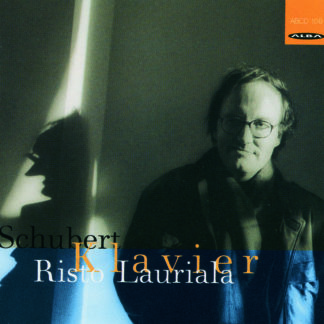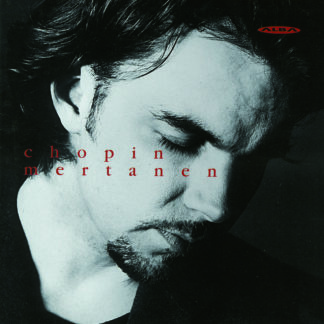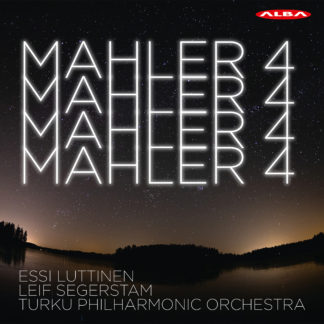Arviot
theartsdesk.com
reviews, news & interviews
Classical CDs Weekly: Mahler, Vaughan Williams, Sandbox Percussion
Two very different symphonies and some new music for percussion
Mahler: Symphony No. 4 Turku Philharmonic Orchestra/Leif Segerstam, with Essi Luttinen (mezzo-soprano) (Alba)
Mahler: Symphony No. 4 Turku Philharmonic Orchestra/Leif Segerstam, with Essi Luttinen (mezzo-soprano) (Alba)
Leif Segerstam can be a maddeningly inconsistent conductor, a musician whose recordings can frustrate as much as they inspire. He’s recorded Mahler 4 before, unremarkably, with Danish forces on Chandos, so it’s good to report that this new Finnish version is a zinger. The Turku Philharmonic’s lean, clear sound suits this transparently scored symphony especially well, though there’s no lack of weight in the bigger climaxes. Intermittent dark clouds may threaten the symphony’s serene surface, but they don’t need overemphasis, and Segerstam’s wide-eyed delight is just what we need at the moment. Mahler isn’t all Sturm und Drang. Several passages in the first movement are genuinely funny here, the principal clarinet and bassoon deserving shout-outs. Flutes sound like penny whistles when they’re singing out their big tune seven minutes in, and the calmness, the peace which Segerstam conjures just before the first movement’s cheery coda is magical.
That sets a pattern for what follows, with a pungent scordatura violin solo in the scherzo and a dreamy trio. The booklet lists Segerstam’s timing for the third movement at 30 minutes, but that’s thankfully a typo; at 22 minutes he’s just fine. You’ll be pleasantly surprised by the wildness of the big eruption near the end, but that’s surely what Mahler wanted, and the ethereal music which follows is superbly handled. Mezzo-soprano Essi Luttinen’s darker tone may not be to all tastes in the vocal finale, but there’s no trace of archness, Segerstam bringing out the charm in Mahler’s instrumental writing. The close is blissful. Unexpectedly excellent – if you love this symphony, you need to hear this disc.
Graham Rickson, 12.9.2020
Music Web International
Gustav MAHLER (1860-1911)
Symphony No.4 in G (1899-1900) [61:38]
Essi Luttinen (mezzo)
Turku Philharmonic Orchestra/Leif Segerstam
rec. Turku Concert Hall, Finland, 27-29 May 2019. DDD.
Text and translation of finale included
ALBA ABCD454 [61:38]
I’ve just finished my share of updating Tony Duggan’s very popular Synoptic Survey of the Mahler symphonies. That update includes a brief review of this new recording along with Tony Duggan’s choices and some of the newer recordings of Symphony No.4 which have appeared since 2006.
As Tony Duggan left matters, his favourite versions were ‘Horenstein, Kubelík and Kletzki from the past generation, and Gatti, Boulez and Tilson Thomas from the present’ with that of Michael Tilson Thomas ‘a truly great version and certainly the best all round for performance and recorded sound together’.
Some of those older recordings are now hard to come by; I’ve included details in my update.
I’m surprised that Bruno Walter and George Szell, both recorded by CBS didn’t make the final cut. The Szell, with Judith Raskin an ideal soloist, is available only as a download, without booklet, and more expensive than when it was available as a budget CD (Sony G0100013929977, with Lieder eines fahrenden Gesellen, Andew Davis, or Columbia G010003872253J). The Sony costs around £12 in lossless sound – as much as you would expect to pay for a new recording. The Columbia is less expensive, around £8.50, but offers the symphony only. Some dealers still have the Sony CD for around £10.
Ever since it appeared as one of the earliest CBS classics LPs at mid-price, having been released at full price only two years earlier, I’ve been a fan of Szell’s way with Mahler, not just in the Fourth, but in the Sixth (Sony 88697008132 – review, now download only) and Des Knaben Wunderhorn, with Schwarzkopf and Fischer-Dieskau (Warner Original Jacket 9029573984, around £7.50 – review of earlier reissue).
Generally regarded as a martinet conductor, Szell nevertheless captures the spirit of No.4; he’s well served by Judith Raskin in the finale and, of course, his own Cleveland Orchestra offer model playing. There’s a hi-definition version of Szell’s Fourth, but I can’t recommend it – the top line sounds too shrill. The Sony CD, which is my benchmark for this symphony, sounds much better.
My other benchmarks include Tilson Thomas – on that I very much concur with Tony Duggan – who makes a very slow tempo for the third movement work well where others fail to do so – DL Roundup August 2010. (SFS Media SFS0004).
Mahler asks for the third movement to be Ruhevoll (restful), poco adagio, which usually means an overall timing of around 23 minutes, sometimes as short as 21 minutes, for example from Iván Fischer with the Budapest Festival Orchestra (Channel CCSSA26109, SACD). That’s one of the recordings which has appeared since TD’s survey (in 2009). Leslie Wright thought it the version to beat (Recording of the Month – review) and I now regard it as my third benchmark; having originally disliked it, as heard in mp3, listening to it again in better, 24-bit, sound I had a real change of heart (DL Roundup November 2011/1). The moral is always to go for the best possible sound – from SACD where available, or 24-bit download.
Michael Wilkinson, reviewing the recent Osmo Vänskä recording (BIS-2356 SACD, reviewed by me in 24-bit stereo from eclassical.com), thought that it ranked with the very best. Despite my own low expectations, he seems much more attuned to the world of this last of the Wunderhorn symphonies than to its successors. Tilson Thomas has demonstrated that a very slow tempo works for the third movement and it works well for Vanskä, too. All in all, I enjoyed the Vänskä Fourth – and, incidentally, his Seventh – much more than I had expected, but the Klimt-inspired cover is hardly appropriate for this symphony.
Leif Segerstam recorded some of the Mahler symphonies for Chandos quite a while ago. His recording of the Fourth, on CHAN9836, earned a degree of praise from Tony Duggan as a persuasive alternative to the mainstream views of Kletzki, Szell, Horenstein and Kubelík – review. That recording remains available from chandos.net as a download (mp3 or lossless) or as a CDR to special order.
Segerstam’s view of the outer movements on the new Alba recording remains largely unchanged, but he now takes longer over the second movement and is faster in the third. I’ve already said that in the first movement a sense of rubato is all-important; get it right and it sounds natural, get it wrong and it’s simply artificial. I initially thought that Iván Fischer made it sound artificial, though I came to think otherwise, but I doubt that I shall warm to Segerstam in the same way. It’s as if he wants to underline every detail, to extract every ounce of drama. With the Turku Philharmonic Orchestra serving him rather better than the Danish Radio Orchestra on Chandos, that’s not necessarily a bad thing, though it impedes the flow of the music. Tony Duggan’s three-word summary of the earlier Chandos recording is largely applicable to the new release: dramatic, romantic and often mannered.
At least, the third movement is not as slow as before, though the effect remains deeply expressive – I find myself continually using Tony Duggan’s words – and a call to rethink for all those who consider this the most placid of Mahler’s symphonies.
Whatever has gone before, any recording of this symphony stands or falls with the quality of the soloist in the finale. Too operatic and the fairy tale atmosphere is lost; too little-girlish and it sounds as if the singer is in heavy weather. Given that Emma Kirkby never recorded it, Judith Raskin for Szell comes pretty close to the ideal. I’m aware that voice quality is the most subjective thing about reviewing – having just heard Dame Sarah Connolly in Das Lied von der Erde, I seem about to become in a minority of one in not raving about that new Pentatone recording – but Essi Luttinen also seems just right here.
The new Segerstam recording leaves me with a good feeling after this account of the finale, and Alba have recorded his team in good quality. There’s even a hi-res download from Qobuz, which I sampled as well as the CD; it’s available for £11.99, which is less than you would pay for the CD, and it comes with the booklet in pdf format. All in all, however, though you wouldn’t go too far wrong with this new recording, there is better to be had. Even after my lengthy excursion through the world of Mahler’s Fourth, I find myself returning to Szell, Tilson Thomas and Iván Fischer, with no sense of reviewer fatigue.
Brian Wilson
Fanfare Magazine
MAHLER Symphony No. 4 • Leif Segerstam, cond; Essi Luttinen (mez); Turku PO • ALBA 454 (Streaming audio: 61:40) https://www.naxosmusiclibrary.com/catalogue/item.asp?cid=ABCD454
Leif Segerstam leads here the most serene and fluid Mahler Fourth I have yet heard—and definitely the most innocent sounding by my lights. I should explain that I tend to have a troubled relationship with edginess in Mahler’s writing, so I lean in plummy directions. As usually performed, there’s an astringency, an acidic quality in Mahler, which intrudes upon innocence. Just when you think all’s well in the world, Mahler has a way of letting bitter woodwinds and sarcastic brasses spoil your reverie. In a piece as essentially sweet as the Fourth Symphony, this can easily raise issues of sincerity. One wonders, is this supposed to be a depiction of heaven—or is it all a devil’s trick?
Segerstam solves the issue for me in a rare way. What he does is have the orchestra play slowly enough throughout to round the corners on wind entries, permitting phrases to swell and dovetail and fade rather than just harshly appear. Harmonies don’t clash—they blend and blossom. The Turku Philharmonic has a creamy sonority, rich smooth horns and, despite its moderate size (five double basses), ethereal strings capable of playing so quietly the hair on your arm stands up. The opportunities Segerstam finds for floating in and out of phrases are legion. Beautiful joins unify the music and keep it from sounding slow. Instruments you never thought capable of it are made to glide and slink, often almost inaudibly at phrase endings, creating a lovely sound world. I think this attention to interactive sonority is the composer in Segerstam emerging, but it all works perfectly here. And lo and behold, one believes in the essential innocence of the music again.
Even the Devil is more seductive than usual here, slow and teasingly amorous in the Scherzo, though I don’t suppose that makes him any nicer. But Segerstam has the violin sounding almost like an ondes Martenot. I keep discovering new fascinations in this performance. I also don’t think I have often heard a recording with more natural and attractive engineering than this. Even cymbals sound appealing, as if made of heavier alloys than usual. The slow movement is magical and its climax, though loud, manages not to set the teeth on edge.
There’s a slight catch, though. After all the soft beauty which has come before, one expects girlishness in the finale, hoping for someone like Lisa Della Casa. But Essi Luttinen has a prominent vibrato and an imperious projection initially at odds with youth and innocence. Even so, Segerstam makes it all work, and Luttinen soon becomes more lyrical. The ending of the symphony is magical. I come away feeling I’ve been scuba diving in clear waters.
Steven Kruger
This article originally appeared in Issue 44:3 (Jan/Feb 2021) of Fanfare Magazine.
Fanfare Magazine
MAHLER Symphony No. 4 • Leif Segerstam, cond; Essi Luttinen (mez); Turku PO • ALBA 454 (61:40 )
I trust composers to be good conductors of their own music and sometimes inspired ones in the music they love, as Leif Segerstam has been with the symphonies of Sibelius. His own symphonies can be contemporary in the extreme, but there’s a change of personality, musically speaking, in this affectionate reading of the Mahler Fourth. The Turku Philharmonic, founded in 1790, is the oldest in Finland and one of the world’s oldest orchestras still playing. I’ve rarely heard their recordings, but here Segerstam inspires characterful playing at every turn—I was impressed and surprised. No excuse needs to be made for this not being the Vienna or Berlin Philharmonic; in terms of exuberance and commitment, the playing serves Mahler’s score beautifully, making the most of one of the century’s greatest orchestrators.
Segerstam has always been a freewheeling conductor, and he’s in the tradition of Willem Mengelberg in using his musical instincts in phrase-shaping, tempo changes, and rubato. Mahler’s piano roll of the Fourth’s finale sounds even more extreme in that regard, and Segerstam, though occasionally willful by today’s standards, has a real feeling for this music. The late-Romantic era had its own authentic style, just as the Baroque has. But fair warning goes out to listeners who prize the literal and unsmiling approach of George Szell in the Mahler Fourth.
The first movement is delightfully varied and free-spirited. As the total timing suggests, Segerstam is relaxed in his tempos. The same is true in the second movement, where he deliberately tries to be funny. Mahler had a sense of humor he thought nobody among his critics appreciated, and Segerstam verges on the buffoonish at times. But I didn’t feel that he went over the edge, and it was fascinating to have the impression that the Devil’s fiddle is Mahler making fun of himself. The recorded balance is a bit off in this movement; the first horn is in your lap and the concertmaster’s solos 20 feet back.
In his lifetime Mahler was both demonized and idolized, and the shameful specter of anti-Semitism played its ugly part. His detractors conceded that he was a brilliant composer of songs, however, and the slow movements in the symphonies were admired when the other movements seemed vulgar or emotionally excessive. Even with a fairly small-sounding string body and a recorded balance that thrusts the woodwinds forward, Segerstam gives a radiant reading of the Adagio, capturing the melting simplicity of the main theme, the dancing liveliness of the second theme, and the power of the passionate brass interjection as Heaven’s Gate opens with a joyful noise. The only objection I can foresee might come from those who feel the woodwinds and brass are dominating where they shouldn’t. But few interpretations are better at handling the serene and seismic polarities in this movement.
Collectors well know that the singer in the finale can upset the whole performance, but Essi Luttinen sings beautifully. Although listed as a mezzo, the Turku-trained singer has a lovely, light tone, and unlike many lyric sopranos, she easily negotiates the lowest notes in her solo. A fast vibrato adds vibrancy to her singing, and even though Luttinen’s German is fairly approximate, she fits very well into Segerstam’s conception of the finale, which maintains his relaxed, affectionate mood.
This somewhat unassuming release has a great deal going for it, not least the surprising variety Segerstam finds in such familiar music. It is warmly recommended as a thoroughly enjoyable listen that surpasses recordings by some more famous conductors and world-class orchestras.
Huntley Dent
This article originally appeared in Issue 44:3 (Jan/Feb 2021) of Fanfare Magazine.






